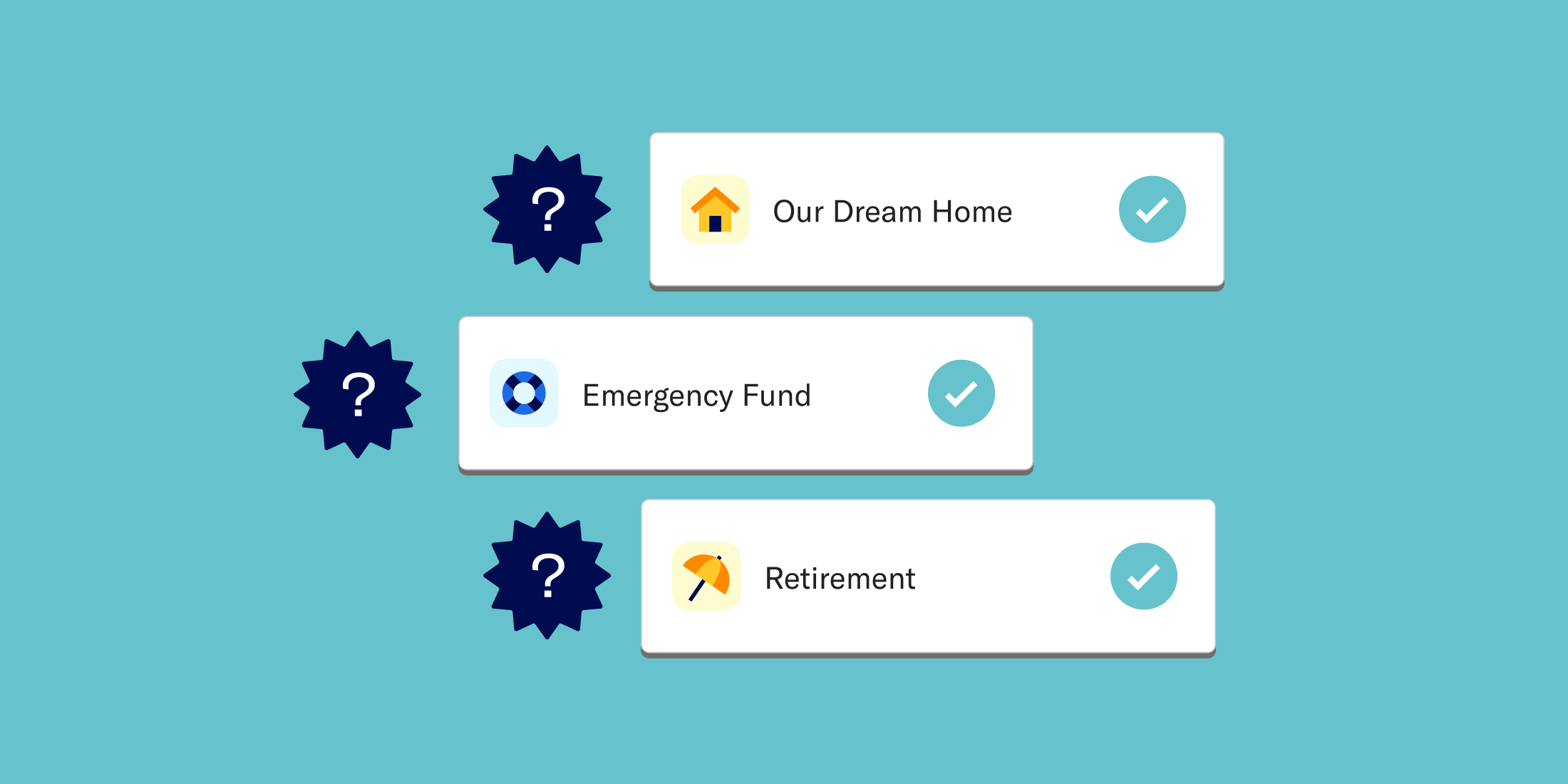Financial Goals

Featured articles
-
![]()
Three ways to put your bonus to work
Cash windfalls can have the power to supercharge your savings goals.
Three ways to put your bonus to work Cash windfalls can have the power to supercharge your savings goals. Year-end bonuses are a blessing. And while there’s no guarantee you’ll get one—just ask Clark Griswold—if you do, they can have the power to supercharge your savings goals. So while you wait for that bonus cash, read up on three ways to handle small cash windfalls such as these. Go 50/50: Treat yourself now and save for the future Let’s address the elephant in the room: A lot of us spend the bulk of our bonuses. But there’s a psychological workaround to this temptation: Think of yourself as two people. There’s “present-day” you, flush with cash and eyeing a few items on your wish list. Then there’s “future” you and all of their dreams for major purchases or financial freedom. Since both of you can rightly lay claim to your bonus, the only fair thing to do is split it 50-50. So go ahead: Splurge guilt-free with one half of your bonus, and save the other half. Tax-savvy saving: Use your bonus to get a tax break A lot of companies withhold taxes on bonuses at the IRS-recommended rate of 22%. Less commonly, some companies lump it in with your regular paycheck, and your regular withholding rate applies. Either way, and contrary to popular belief, bonuses aren’t taxed at a higher rate. But seeing your bonus shrink due to any amount of taxes is still rough. Thankfully, you may able to minimize your tax hit with the help of a tax-advantaged retirement account: Boost your 401(k) contributions. In some cases, companies allow employees to make 401(k) contributions with their bonuses. If that’s the case for you, consider funneling “future” you’s half of your bonus into your traditional or Roth 401(k), up to the IRS limits. Traditional for a tax break now, Roth for a tax break later. Max out your IRA. Depending on how much income you make, you may be eligible to deduct traditional IRA contributions from your taxes and/or contribute after-tax dollars to a Roth IRA for a tax break later. Better yet, you have until Tax Day of 2025 to max out your 2024 IRA! Stash the cash: Start earning interest today Tax breaks aren’t the end-all, be-all, of course. In some scenarios, saving your bonus in a high-yield cash account like our Cash Reserve account might take priority. If you lack an emergency fund, for example, or if you’re planning for a major purchase in the near future. However you save or invest your bonus, rest easy knowing you’re striking a good balance between today and tomorrow. Unless your bonus came in the form of jelly, in which case you’re on your own, Clark. -
![]()
How much cash is too much cash to be in savings?
Cash is great. But can you have too much? And what should you do with it? Let’s find out.
How much cash is too much cash to be in savings? Cash is great. But can you have too much? And what should you do with it? Let’s find out. The main point: If you have too much cash in savings, you may be missing out on growth from stock or bond investments. Consider having cash in savings for short-term needs and putting the rest into investing accounts. Facts about cash in savings: Cash in savings is liquid, meaning it is easy to access when you need to withdraw it for spending. Cash in savings is also low risk, meaning your money should not decrease in value like stocks if you stay within FDIC insurance limits. But—cash in savings does not have the opportunity to grow compared to cash in stocks and bonds, especially when savings rates are not keeping up with inflation. Finding a balance: To strike the right balance between cash and investments, consider the following: Cash is a secure option for your emergency fund. Most experts recommend having three to six months of living expenses saved. Cash is the lowest-risk option but you can use a mix of bonds and stock too. Take a close look at your situation and save what feels right for you. After that, take a look at your extra cash. Cash and investments can also be right for your short-term goals. Having cash in savings can be wise for short-term goals (we consider anything under 12 months short-term). But depending on how you’re defining short-term and your risk tolerance, you may consider putting some cash for shorter-term goals in bonds and stocks. Investments can support your long-term goals. For most goals longer than 12 months, consider putting your cash into stock and bond investments. While investing involves more risk, stocks have had greater long-term gains historically than leaving your cash in savings. We have options for you: Open a Cash Reserve account if you’re looking for a secure way to save. It’s a high-yield cash account that helps grow your savings while offering FDIC insurance† up to $2 million ($4 million for joint accounts) through our program banks (up to $250,000 of coverage for each insurable capacity—e.g., individual or joint—at up to eight Program Banks), subject to certain conditions. We, Betterment, are not a bank ourselves. Open an investing account for your long-term goals. We’ll help assess your risk tolerance, provide investment recommendations, and make it easy to access expert-built portfolios to get you closer to your goals. -
![]()
How to manage debt and invest at the same time
With the right strategy, it's possible to make progress on both goals.
How to manage debt and invest at the same time With the right strategy, it's possible to make progress on both goals. Managing debt and investing is a tricky balancing act. You can’t do everything at once, but paying off debt and building wealth are both vital to your financial future. In this guide, we’ll explain how to manage debt and invest in six steps: Account for your spending Make minimum debt payments Contribute to an employer-matched retirement plan (if you can) Focus on high-interest debt Build an Emergency Fund Invest for the long-term First, let’s talk about your debt, your goals, and your repayment strategy. Planning around your debt Debt can completely derail your financial goals. It eats through your savings and can offset the gains you make through investing. Repaying major debt like student loans can feel like climbing a mountain. But not all debt is the same. High-interest credit card debt will quickly outpace your investment earnings. Ignore it, and it will consume your finances. Debt with lower interest rates, like some student loans or your mortgage, can be much less of a priority. If you put off investing in favor of attacking this debt, you may not have time to reach your goals. It is possible to pay debt and invest at the same time—the key is to create a strategy based on your debt and your financial goals. At Betterment, we recommend focusing on the debt with the highest interest first. The more time you give this debt to grow, the harder it becomes to pay off. Now let's walk through Betterment’s six steps to manage your debt and invest. Step 1: Account for your spending Your finances are finite. You have a limited amount of money to pay down debt, invest, and cover your expenses. The first step is to learn what comes in and goes out each month. How much do you have to work with after rent, food, utilities, and other fixed expenses? Are there expensive habits you can eliminate to free up more money? Don’t plan to make changes you can’t stick to. The goal here is to establish a monthly budget, so you have enough to cover your bills and know how much you can save or put towards debt. We also recommend keeping enough in your checking account to act as a small buffer—three to five weeks of living expenses is generally a good rule of thumb—as even the best laid plans (or budgets) are derailed at times. Step 2: Make minimum payments You really don’t want to miss your minimum payments. Fees and penalties make your debt hit harder, and they’re usually avoidable. Think of your minimum debt payments as fixed expenses. After your regular living expenses, minimum debt payments should be a top priority. Step 3: Contribute to an employer-matched retirement plan If your employer offers to match contributions to a 401(k), that’s free money! Don’t leave it on the table. A 401(k) also comes with valuable tax benefits. Even if it under performs, the match program allows your contributions to grow faster. It’s like your employer is giving your financial goals a boost. And that’s why this is almost always one of the smartest investment moves you can make. Step 4: Focus on high-interest debt When it comes down to it, high-interest debt is your biggest enemy. It’s a festering financial wound that grows faster than any interest you’re likely to earn. Left unchecked, credit card debt can easily cost you thousands of dollars in interest or more. And that’s money you could’ve invested, applied to other debt, or saved. Step 5: Build an Emergency Fund Without an emergency fund, you’re one unexpected medical bill, car accident, or surprise expense away from even more debt. Generally we encourage you to pay off your high interest debt before fully funding a three to six month emergency fund. However, some people, particularly those who are worried about income loss, prefer building a large cushion of cash for emergencies first over paying down extra debt Step 6: Invest for the long-term Once you’ve paid down your high-interest debt, you can begin investing for the long-term. With a diversified portfolio, your investments can outpace your lower-interest debt. So you can work toward financial goals while making minimum payments. Using automatic deposits, you can create an investment plan and stick to it over time, treating your investments as part of your fixed budget. Your emergency fund will give you some financial breathing room, and before you know it, you’ll be making progress toward retirement, a downpayment on a house, college for your kids, or whatever your goal is.
Considering a major transfer? Get one-on-one help with one of our experts. Explore our licensed concierge
All Financial Goals articles
-
![]()
Three keys to managing joint finances with your partner
Three keys to managing joint finances with your partner Nov 1, 2024 8:00:00 AM Talking about money with your partner can be a difficult conversation. The key is to have open communication, sooner rather than later. Money has wrecked its fair share of relationships. Maybe you’ve even seen one of yours go up in flames because of it. But it doesn’t have to. And while every partnership is different, we’ve seen an emphasis on three areas help our clients avoid the worst of money fights: Communication Prioritization Logistics Whether you’re married or not, and whether you join your accounts or keep them separate, they can help soften one of love’s thorniest topics. Open (and keep open) those lines of communication When you choose to share your life with someone special, you bring all sorts of baggage with you. Among the bags you might want to start unpacking first is your relationship with money. It could be complicated, and there’s probably all sorts of emotions wrapped up in it—especially with debt—but transparency can help avoid unpleasant surprises down the road. So to start with, try sizing up the financial state of your union by crunching a few numbers for each of you: Net worth (assets − liabilities) This can be the most emotionally-charged of numbers, and it’s no surprise why. It’s right there in the name: net worth. We tend to bundle up our concept of our own self-worth with our finances, and when those finances don’t look pretty, feelings of shame or embarrassment may follow. So it’s important to support each other during this exercise. Help your partner feel safe enough to share these sensitive details in the first place. When you’re both ready, add up all your assets (cash, investments, home equity, etc.), then subtract your total liabilities—namely debt (credit cards, student loans, mortgage, etc.)—to get a good sense of your separate and combined balance sheets. If you’re a Betterment customer, connecting your external financial accounts to Betterment can be a handy shortcut for this number-crunching. Cash flow (income − expenses) Now comes the time to size up how much money is coming in and going out each month, with the difference being what you currently have available to save for all your goals (more on those later). For simplicity’s sake, it can be easier to start with your take-home pay, which may already factor in payroll taxes and expenses such as health care insurance. If you already contribute to a 401(k), which automatically comes out of your paycheck, be sure to count this toward your tallied savings when the time comes! Toss in a survey of your respective credit scores, which could affect future goals such as home ownership, and you’ve started to lay the foundation for a healthier money partnership. And by no means is this a one-time exercise. For some couples, it helps to schedule a monthly financial check-in. Why monthly? Some people don’t like talking about finances at all. A monthly check-in gives you a safe space to start the conversation. Others think and talk about money all the time, which can be draining on a partner. Unless it’s urgent, you can make a note and wait to bring it up until the next check-in. A recurring monthly check-in solves both these problems and provides a forum to talk about upcoming big expenses and important money tasks, among other things. To make things fun, you can build your check-ins around something you already enjoy, like a weekend morning coffee date. Prioritize as partners With key details like your net worth and cash flow in place, next comes the process of visualizing what you—as individuals and as a couple—want your money to do for you and your family. Couples don’t always see eye-to-eye on this, so now's the time to hash out any differences of opinion. If you have financial liabilities, know that it’s possible to manage debt and save at the same time; it all comes down to prioritizing. In general, we recommend putting your dollars to work in this order: Assuming your employer offers a 401(k) and matching contribution, contribute just enough to your 401(k) to get the full match so you’re not leaving any money on the table. Address short-term, high-priority goals such as: High-interest debt Emergency fund (3-6 months’ worth of living expenses) Save more for retirement in tax-advantaged investment accounts such as a 401(k) and IRA. How much more? Sign up for Betterment and we can help you figure that out. Save for other big money goals such as home ownership, education, vacations, etc. The devil is in the details with #4, of course. And you may not be able to save as much as you need to for every single goal at this time. Just know that if you start at the top and set specific goals—”I’ll contribute X amount of dollars each month to pay off my high-interest debt in X number of years,” for example—you’ll eventually free up cash flow to put toward priorities that fall further down on your list. Tend to the logistical paperwork With your planning well underway, next comes execution. How exactly will you set up your financial accounts? If you’re married, will you file taxes jointly or separately? And how will you update (or set up for the first time) your estate plan? These are three big questions best to start considering now. Set up your accounts for success There’s the process of jointly managing finances with your significant other, then there's the actual act of opening joint accounts. These are accounts you both share legal ownership of. Whether or not you decide to keep all or some of your accounts separate is a highly-personal decision. One way to address it is the “yours, mine, ours” approach, also known as the “three-pot” approach. To keep some financial autonomy, you and your partner might each maintain credit cards and checking accounts in your own names to cover personal expenses or debt repayments. The bulk of your monthly income, however, would go into a joint account to cover your monthly bills and shared expenses. Head on over to our Help Center for more information on how to manage money with a partner at Betterment. If you’re married, weigh the pros and cons of filing taxes jointly In most cases, the financial benefits of you and your spouse filing one joint tax return will outweigh each of you filing separately, but it‘s important to know and understand your options. When you choose to file separately, you limit or altogether forgo several tax breaks and deductions including but not limited to: Child and Dependent Care Tax Credit Earned Income Tax Credit The American Opportunity Credit and Lifetime Learning Credit for higher education expenses The student loan interest deduction Traditional IRA deductions Roth IRA contributions That being said, you might consider filing separately if you find yourself in one of these scenarios: You and your spouse both have taxable income and at least one of you (ideally the person with the lower income) has significant itemized deductions that are limited by adjusted gross income (AGI). You participate in income-driven repayment plans for student loans. Filing separately may mean lower monthly loan payments in this scenario. You want to separate your tax liability from your spouse’s. If you know or suspect that your spouse is omitting income or overstating deductions and/or credits, you may want to file separately. You and/or your spouse live in a community property state. Special rules apply in these states for allocating income and deductions between each spouse’s tax return. We’re not a tax advisor, and since everyone’s situation is different, none of this should be considered tax advice for you specifically. If you have questions about your specific circumstances, you should seek the advice of a trusted tax professional. Update (or establish) your estate plan An estate plan can define what will happen with the people and things you’re responsible for if you die or become incapacitated. Who will make medical or financial decisions on your behalf? Who will be your child’s new guardian? How will your finances be divided? Who gets the house? If you haven’t yet created one, now may be the time. And if you have, it’s important to keep it up-to-date based on your latest life circumstance. Don’t forget to update your beneficiaries on any accounts that may pass outside the estate. That’s because beneficiary designation forms—not your will—determine who inherits your retirement savings and life insurance benefits. You can review, add, and update beneficiary listings on your Betterment accounts online. -
![]()
How to talk money with your aging parents
How to talk money with your aging parents Jul 9, 2024 11:43:32 AM Talking about their financial future isn’t easy, but it’s important Talking money with your parents is no one’s idea of a good time. But as you enter middle age, and they enter their Golden years, it’s important to create an open dialogue. Because one day, you could be pressed into duty helping them manage their finances, or even stepping in with financial support yourself. Pew Research Center polled adults with an aging (65+) parent and found it’s more common than you might think. So before you buy another bouquet of flowers, or another tacky tie, consider gifting your parents an awkward but meaningful conversation on money’s role in aging with grace. Here's how. Step into their shoes, then switch mindsets If you think it's hard having this “talk” with your parents, imagine how they must feel. Maybe they're afraid their money won't last. Maybe they're too embarrassed to ask for help. From anyone, let alone someone whose diaper they once changed (and changed, and changed). This sort of empathy sets the stage for a true heart-to-heart. Sure, you could share any number of practical tips—everything from catch-up contributions and safe withdrawal strategies to (quick plug) how awesome Betterment is and how easy it is to switch—but those conversations are best left for another day. What matters most in these first few exchanges is to build trust, and to come at things through the lens of curiosity, not problem-solving. To that end, we leave you with a few suggestions. Three ways to set the table, and three icebreaker ideas Depending on your relationship with your parents, there may be no way around this: It will be awkward. Your inquiries may be met with resistance. So start getting comfortable with both possibilities. A few tips can help your odds: Pick a boring time. Steer clear of hectic holidays. Start small. Spread things out over multiple conversations. Stay curious. The questions matter more than the answers. Now, once it’s time to actually start the conversation, consider a few icebreakers: The “23andMe” angle. “I’m curious, how did your parents handle their finances as they aged? Did you ever talk about it with them?” The “I’ll go first” angle. “With the kids getting older, I’ve been thinking more and more about estate planning lately. But it’s all so overwhelming.” The CNBC angle. “Did you see the Dow just dropped [insert number] points? I know it’s easy to overreact, but it stings seeing my portfolio shrink even just a little.” Regardless of where things go from here, remember to give yourself credit. You just took the hardest step (the first one) in joining your parents on their financial journey. And if there ever does come a day when they consider joining you at Betterment, our team is here to help. -
![]()
The keys to building wealth, whether you rent or buy
The keys to building wealth, whether you rent or buy Jun 14, 2024 4:07:01 PM There's more than one path to prosperity To rent or to buy. At some point in your life, adulting may very well boil down to this one anxiety-inducing question. But it’s really two questions wrapped in one. The first is highly-personal: “Which lifestyle is right for me, right now?” And that answer is totally up to you. It’s largely based on individual circumstance, personal preference, and how much time you can handle at The Home Depot. But the second question? It deals with dollars and cents, and it’s right up our alley. So we’re here to offer you a sigh of relief, then help you turn hypotheticals into concrete action. Is renting or buying your primary residence the smarter money move? We’re in the business of building long-term wealth, and on that topic the historical data is pretty clear: both renting and owning a home can generate large sums of wealth in the long run. In the case of homeownership, that’s assuming you live there long enough to build equity and recoup the big, additional expenses that come with purchasing and maintaining it. And with renting, that’s assuming you invest wisely the extra money you would’ve otherwise spent buying and maintaining the home. A real estate investment firm recently crunched 50 years of data (see pages 3-5 for all of their assumptions) to see exactly how each hypothetical scenario fared. Wealth after 30 years *Data shown is for illustrative purposes only, and is not reflective of any Betterment portfolio or performance. As such, this graph does not reflect any of Betterment’s management fees, transaction costs or fund expenses. Renting slightly edges out buying in this study, although a buyer with a paid-off home could arguably close the gap in subsequent years if they invest their old mortgage payments. But these nitpicks miss the point, because in terms of wealth, both people are doing just fine in this hypothetical. So let’s all take a moment to exhale, because you can do well no matter which path you take. In the case of renting, it just requires you to actually invest those savings and not spend them. And we can help with that. How to realize the potential of “renting + investing” Let’s use the median house in America as an example. It costs roughly $415,000. Here’s a rough approximation of how much money you would need, both up front and ongoing, to buy and maintain it. Keep in mind the ongoing costs listed below exclude the mortgage payment itself. Up-front expenses Amount Downpayment (20%) $83,000 Closing costs (2%) $8,300 Agent commission* (3%) $12,450 Total $103,750 Ongoing expenses Property tax** $484 Homeowners insurance $179 Maintenance $534 Total $1,197/month Pay attention to your emotions here, because they can help guide your decision making. If you can’t imagine saving and investing this much money right now, then you may struggle to afford owning the median U.S. home. And that’s okay! One's answer to the Rent vs Buy question may very well change multiple times throughout life. Just remember you can still build wealth while renting. Crunch the numbers above based on your own budget, then follow two steps to see the strategy through to the end: Start saving for those upfront costs now. Once you have that amount in hand, start investing the equivalent of those monthly non-mortgage costs via recurring deposit. Now it’s no longer a hypothetical. You’re putting those savings to work. Should you decide to buy down the road, you’ll be more financially ready—and the tradeoff will be clear as day: Buy a house. Or keep saving at your current levels. There’s no wrong answer here. Whatever you decide will be the right decision for you. And it’ll be an informed one. -
![]()
Too many money goals? We can help.
Too many money goals? We can help. Jul 20, 2023 12:00:00 AM When you have more than one, think in terms of importance, timeline, and the amount you need. In 1 minute Saving for big financial goals like retirement doesn’t have to mean letting go of your other goals. But prioritizing them is tough. How are you supposed to weigh something like a distant retirement versus a more immediate financial goal, like a honeymoon? Or a down payment on a home? Start by identifying all of the things you’d like to achieve. They might be big-ticket items you want to buy, experiences you want to have, or expenses you want to be prepared for. Once you’ve named them, estimate how much you’d need to reach each goal, and how soon you’d like to reach them. After you’ve clearly defined the goals you could save for, it’s time to choose which ones matter most to you. You might rank every goal or just narrow the list down to your top five to ten. Then you can calculate how much you’d have to save each month to reach these goals based on your timeline. From there, turn to your budget. Decide how much you can afford to save each month and apply it to your biggest goals first. We highly recommend turning on auto-deposit so you won’t be tempted to stop working toward your goals. Your financial goals don’t have to be set in stone, and neither does your plan. Over time, you may find that you can save more—or that you can’t save as much as you thought. Maybe it’ll take more or less to reach your goal. Or your priorities might change. That’s OK. With Betterment, it’s easy to set, automate, and adjust your goals. In 5 minutes In this guide, we’ll cover: Defining your financial goals Prioritizing your goals Deciding how to allocate your money Adjusting goals as needed Financial goals help you plan for the things you’d like to do with your money, but can’t afford to do right now. Like retiring. Buying a house. Sending your kids to college. Getting that dream car. Remodeling your kitchen. When you know what you want to do, you can estimate how much you need and when you need it. Knowing your goals also helps you choose the right financial accounts, so you can reach them sooner. But what happens when you have multiple financial goals? All of a sudden, it’s harder to know how much to put toward each goal. Thankfully, working toward one goal doesn’t mean you can’t reach another. Here’s how to set and prioritize your financial goals. Define your financial goals If you sit down and think about all of the things you’d like to do with your money, you can probably create a much longer list than you’d expect. Do it. It’s worth taking the time to write down every goal—because you might be forgetting something important! Some of your goals could be as simple as saving up for holiday gifts, as important as building a safety net, or as big as planning for retirement or long-term care. If it’s on your mind, put it on the list. Part of this process should involve estimating how much you’d need to save to reach each goal and when you’d like to reach it. Is it months away? Years? Decades? Will it take hundreds of dollars or hundreds of thousands? Each goal should have a timeline and amount. At Betterment, it’s easy to add this information every time you set up a goal. (And you can change it at any time.) Prioritize what matters to you Your financial goals are yours. This isn’t about what your parents want or what your friends expect from you. Whatever your goals are, prioritize them based on how important they are to you. Remember that ranking your goals doesn’t mean you won’t reach the ones on the bottom. For example, you shouldn’t be afraid to pay down debt and invest at the same time. This is just to help you think about which goals you care about the most. Once you’ve ranked your goals, your list might look like this: Pay off medical debt Build emergency fund Save for retirement Put a down payment on a house Remodel the bathroom You can include as many goals as you want. And in Betterment, you can add each goal to your account, whether you put anything toward it or not. Apply your budget to your list Now that you know how much you need to save, when you need to save it by, and which goals are most important to you, it’s time to see what you can actually accomplish. Using your estimated amount and your timeline (in investing, this is called your “time horizon”), calculate how much you need to save each month to reach each goal. It’s OK if this is more than you can afford to save right now. Putting the numbers in front of you with an ordered list helps you ask questions like, “Can I reach all of these goals on these timelines?” and “Which goal(s) am I willing to delay in order to make progress on the others? If you plan on investing to reach your goal, you should also consider how much you can expect to earn toward these goals with an investment account. Every time you set up a goal in Betterment, we’ll handle this part for you. You can see how achievable your goal is based on how much you put toward it. Automate your financial goals The best way to make sure you reach your goals? Automate them. Don’t make the mistake of putting your goals on pause. Set up recurring deposits for each goal with the amount you’ve set aside for them, and the right amount automatically goes to the right goal. This makes it easy to budget around your goals, and you won’t accidentally miss a month. The strategy is often called “paying yourself first” because you’re putting money toward your highest priorities before spending it on anything else. Want to start working toward your financial goals? Set up a goal with Betterment, and see what you can achieve. -
![]()
Understand your net worth with our interactive tool
Understand your net worth with our interactive tool Jul 17, 2023 4:57:01 PM Using our Connected Accounts feature, you can see your total net worth on the Betterment app. We make it simple to view your net worth. That’s your investments, cash, and debts, all on one easy-to-read screen. Why it matters: Net worth is a good indicator of your financial stability because it shows what you have left over after you pay all your debt. See your net worth: Here’s how you can see your total net worth on the Betterment desktop and mobile app. Once you’re logged in, you’ll see the Net worth section. To view your net worth, if you’re on mobile, tap the section or if you’re on desktop, click See breakdown. On the Net worth screen, you’ll see the total value of your internal Betterment accounts and your external accounts. To add external accounts, click Manage connected accounts and follow the prompts. You’ll need to do this for all external accounts to see your total net worth. Now that you know how to set up and view your net worth, what does it all mean? According to the FDIC, net worth is a better measure of financial stability than income for two reasons. Your income could be decreased due to a job loss or reduction in work hours. Your income doesn’t indicate how much debt you have or how much savings or additional assets you have. Take this example: To illustrate what net worth means, consider two people who both make $100,000 per year. Person 1 has $450,000 in cash/investments and $420,000 in debt (net worth: $30,000) Person 2 has $225,000 in cash/investments and $10,000 in debt (net worth: $215,000) All else equal, Person 2 has a higher net worth and is in a better position to create long-term wealth. The big picture: Looking at your finances beyond your income can help you plan for the future. By looking at how much debt you have in addition to savings, you can create a clearer plan for long-term wealth creation. To increase your net worth, you can either reduce liabilities (debt like loans and credit card debt) or increase assets (accounts like cash savings and investments). You have two levers to pull. At Betterment, we give you the tools to increase your net worth. You can set up goals with automated deposits using a high-yield cash account or investment account. Plus, we’ll help you estimate how much you need to save with our goal forecaster tool.
Looking for a specific topic?
- 401(k)s
- 529s
- Asset types
- Automation
- Benchmarks
- Bonds
- Budgeting
- Compound growth
- Diversification
- Donating shares
- ETFs
- Education savings
- Emergency funds
- Financial advisors
- Financial goals
- Getting started investing
- Health Savings Accounts
- Home ownership
- IRAs
- Interest rates
- Investing accounts
- Market volatility
- Performance
- Portfolios
- Preparing to retire
- Retirement income
- Retirement planning
- Risk
- Rollovers and transfers
- Roth accounts
- Stocks
- Tax Coordination
- Tax loss harvesting
- Taxable accounts
- Taxes
No results found








